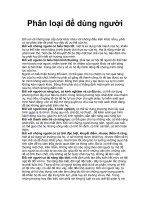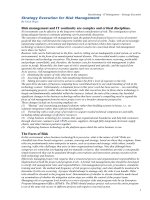Tài liệu Making M&A Deals Happen pptx
Bạn đang xem bản rút gọn của tài liệu. Xem và tải ngay bản đầy đủ của tài liệu tại đây (2.96 MB, 299 trang )
MAKING m & a DEALS
HAPPEN
This page intentionally left blank
McGraw-Hill
New York Chicago San Francisco Lisbon London Madrid
Mexico City Milan New Delhi San Juan Seoul
Singapore Sydney Toronto
ROBERT STEFANOWSKI
MAKING M & A DEALS
HAPPEN
Copyright © 2007 by The McGraw-Hill Companies, Inc. All rights reserved. Manufactured in the United States of
America. Except as permitted under the United States Copyright Act of 1976, no part of this publication may be
reproduced or distributed in any form or by any means, or stored in a database or retrieval system, without the prior
written permission of the publisher.
0-07-150881-3
The material in this eBook also appears in the print version of this title: 0-07-144740-7.
All trademarks are trademarks of their respective owners. Rather than put a trademark symbol after every
occurrence of a trademarked name, we use names in an editorial fashion only, and to the benefit of the trademark
owner, with no intention of infringement of the trademark. Where such designations appear in this book, they have
been printed with initial caps.
McGraw-Hill eBooks are available at special quantity discounts to use as premiums and sales promotions, or for
use in corporate training programs. For more information, please contact George Hoare, Special Sales, at
or (212) 904-4069.
TERMS OF USE
This is a copyrighted work and The McGraw-Hill Companies, Inc. (“McGraw-Hill”) and its licensors reserve all
rights in and to the work. Use of this work is subject to these terms. Except as permitted under the Copyright Act
of 1976 and the right to store and retrieve one copy of the work, you may not decompile, disassemble, reverse
engineer, reproduce, modify, create derivative works based upon, transmit, distribute, disseminate, sell, publish or
sublicense the work or any part of it without McGraw-Hill’s prior consent. You may use the work for your own
noncommercial and personal use; any other use of the work is strictly prohibited. Your right to use the work may be
terminated if you fail to comply with these terms.
THE WORK IS PROVIDED “AS IS.” McGRAW-HILL AND ITS LICENSORS MAKE NO GUARANTEES OR
WARRANTIES AS TO THE ACCURACY, ADEQUACY OR COMPLETENESS OF OR RESULTS TO BE
OBTAINED FROM USING THE WORK, INCLUDING ANY INFORMATION THAT CAN BE ACCESSED
THROUGH THE WORK VIA HYPERLINK OR OTHERWISE, AND EXPRESSLY DISCLAIM ANY WARRAN-
TY, EXPRESS OR IMPLIED, INCLUDING BUT NOT LIMITED TO IMPLIED WARRANTIES OF MER-
CHANTABILITY OR FITNESS FOR A PARTICULAR PURPOSE. McGraw-Hill and its licensors do not warrant
or guarantee that the functions contained in the work will meet your requirements or that its operation will be unin-
terrupted or error free. Neither McGraw-Hill nor its licensors shall be liable to you or anyone else for any
inaccuracy, error or omission, regardless of cause, in the work or for any damages resulting therefrom. McGraw-
Hill has no responsibility for the content of any information accessed through the work. Under no circumstances
shall McGraw-Hill and/or its licensors be liable for any indirect, incidental, special, punitive, consequential or sim-
ilar damages that result from the use of or inability to use the work, even if any of them has been advised of the
possibility of such damages. This limitation of liability shall apply to any claim or cause whatsoever whether such
claim or cause arises in contract, tort or otherwise.
DOI: 10.1036/0071447407
We hope you enjoy this
McGraw-Hill eBook! If
you’d like more information about this book,
its author, or related books and websites,
please click here.
Professional
Want to learn more?
To my parents, Bob Sr. and Eleanor, for realizing that a
good education is one of the best gifts they could provide
to their children, and to my sisters, Patty, Deb, and
Sue for all of their support over the years. Finally, to
Amy, Lauren, Rachel, and Megan for the love, under-
standing, and fun they provide every day!
This page intentionally left blank
CONTENTS
Introduction ix
CHAPTER 1
The M&A Environment 1
CHAPTER 2
Sourcing the Deal 9
CHAPTER 3
The First Round 27
CHAPTER 4
Due Diligence: The Internal Side 45
CHAPTER 5
Due Diligence: The External Side 61
CHAPTER 6
Financial Modeling and Final Valuation 75
CHAPTER 7
Pulling It All Together 95
CHAPTER 8
Final Bid Strategies/Structuring the Deal 107
CHAPTER 9
Legal, Regulatory, and Other Issues 127
CHAPTER 10
The Importance of Integration 153
CHAPTER 11
Special Considerations for Sellers 173
CHAPTER 12
M&A Trends, Career Paths, and Other Topics 187
vii
For more information about this title, click here
APPENDIX A
Ten Steps for Better Acquisitions 201
APPENDIX B
Sample Due Diligence Information Requests 207
APPENDIX C
Sample Asset Purchase Agreement 219
INDEX 273
viii Contents
INTRODUCTION
This book is designed to give the reader a practical, busi-
nessperson’s approach to M&A by providing a road map on how
to source, negotiate, and close mergers, acquisitions, and joint
ventures. We will discuss each stage of the typical deal process,
highlighting the critical elements, risks, and opportunities of
each. Whether you are a business professional in the M&A field,
an investment banker, a chief executive officer with overall busi-
ness responsibility, or a student who has an interest in learning
about the deal process, this text should help to make you more
effective in your work.
America’s fascination with the stock market and the contin-
ued pressure on corporations to grow has resulted in a prolifera-
tion of M&A activity in recent years, both in the United States
and abroad. As a result, the ability to understand M&A and get
deals done has become a critical skill in corporate America.
Whether someone is directly or indirectly involved in the deal
process, a basic understanding of business combinations is essen-
tial to success in business today. Although this book is written
from the perspective of a deal principal (i.e., a corporation that is
contemplating some type of business combination: merger,
acquisition, joint venture, and so on), the information is useful to
a variety of constituencies including the following:
Corporate business development groups. The term business devel-
opment will be used throughout the text to indicate those
corporate professionals whose primary responsibility is to
grow their companies by purchasing or merging with other
firms. In some organizations, these efforts are referred to as
the Strategic Development, Corporate Development, or
simply M&A Department.
Related corporate roles. Although they are not directly respon-
sible for M&A activity, it is essential that people in various
senior corporate roles, such as chief executive officer, chief
financial officer, and chief operating officer, have a working
understanding of the M&A process and its risks and oppor-
ix
Copyright © 2007 by The McGraw-Hill Companies, Inc. Click here for terms of use.
tunities. As we will see in Chapter 1, failure of company
managers to understand this process can have a dramatic
effect, both on their companies and on their individual
careers.
Investment banks. For larger or more complicated transactions,
both the buyer and the seller generally hire investment
bankers. Having a working understanding of the process and
the issues facing the principals in these transactions is essen-
tial to the effectiveness of any investment banking profes-
sional. By guiding the reader through the M&A process and
its potential pitfalls, this book will enable the current or
future investment banker to be much better prepared to
serve his or her clients.
Private equity professionals/LBO groups/hedge funds. The 1990s and
2000s have seen a proliferation of private equity groups and,
more recently, hedge funds that have an interest in equity
investing. The legendary firms such as Kolhberg, Kravis, and
Roberts (KKR), with its hostile takeover of Nabisco (as popu-
larized in the book/movie Barbarians at the Gate) have evolved
into an extensive network of private funds focused on buying
companies for their own account.These partnerships are gen-
erally formed by investment professionals financed by a
group of wealthy investors, pension funds, or other institu-
tions. The purpose of these equity funds is to locate attractive
companies for purchase, run the companies for a period of
time, and, hopefully, sell the company for a profit at some
point in the future to provide a return on capital to the
investors. As we will discuss later, the billions of dollars in
capital raised by these funds have had a dramatic impact on
the dynamics of the M&A industry. Most, if not all, of the
issues faced by M&A professionals in a corporate environ-
ment are identical to those faced by private equity groups
arranged to buy and run companies.
Other advisors. Employees of a wide variety of other players,
including legal and tax advisors, appraisal firms, public
relations firms, and other such organizations, need to
understand the M&A process. Having an adequate under-
standing of the process can be critical to the success or fail-
ure of these individuals.
x Introduction
COMMON DEFINITIONS
“M&A” is a generic term that can have a variety of meanings,
depending on the context. The discussion in this text is applica-
ble to all forms of M&A transactions, as outlined here:
■
Acquisition. The 100 percent purchase by one company of
another. The target company is normally absorbed by the
acquirer and no longer exists as a separate entity after the
deal closes.
■
Merger.The combination of two companies/legal entities
into one. This normally occurs in situations where two
companies of similar size and characteristics agree to com-
bine their efforts.
■
Minority equity investment. Something less than a 100 per-
cent purchase. A minority equity investment provides
the buyer with a portion of the equity value in the tar-
get without having operating control of the firm.
■
Joint venture/strategic alliance. The process whereby two
companies decide to work together on some portion of
their existing or future business. For example, Dow
Introduction xi
EXHIBIT I-1
The Dow Corning Joint Venture
Dow Corning Corporation (Dow Corning) was incorporated in 1943 by Corning
Glass Works (now Corning Incorporated) and The Dow Chemical Company (Dow
Chemical) for the purpose of developing and producing polymers and other materials
based on silicon chemistry. Corning Incorporated provided the basic silicone technology
and Dow Chemical supplied the chemical processing and manufacturing know-how.
Both companies contributed key employees to the venture, while maintaining their
own separate, distinct operating companies. Dow Corning became a wholly owned
subsidiary, owned 50 percent by Dow Chemical and 50 percent by Corning, Inc. Dow
Corning currently manufactures over 10,000 products and serves approximately
50,000 customers worldwide.
Discussion Questions
1. What are the benefits of this joint venture combination as opposed to a 100 per-
cent purchase of one company by the other?
2. What are some issues that could arise from such a structure (that is, 50/50
ownership)?
3. Is there anything unique about this situation that lends itself to a joint venture
arrangement?
Chemical and Corning Incorporated formed a joint ven-
ture called Dow Corning to develop new products that
leveraged the core competency of each business. The joint
venture structure allowed the firms to work together on
new product development, while still leaving the core
operations of each business unit separate. (See Exhibit I-1,
“The Dow Corning Joint Venture.”)
We will also frequently refer to the concept of “due dili-
gence” throughout the course of this book. Due diligence repre-
sents the financial, operational, and strategic analysis that a buyer
undertakes when evaluating (1) whether to purchase a target
company, (2) how to structure the deal, and (3) how much to pay.
A detailed description of the due diligence process is provided in
Chapters 4 and 5.
NOTES
Bryan Bullough and John Helyar, Barbarians at the Gate: The
Fall of RJR Nabisco (New York: Harper Perennial Press,).
xii Introduction
ACKNOWLEDGMENTS
I would like to thank the following people who were critical to
the development of this book: Irene McGeachy, my outstanding
assistant who helped in production; Pattie Amoroso at McGraw-
Hill, for her editing and production expertise; Mark O’Leary, who
“volunteered”to read the entire text and made great suggestions;
and Dave Wente, Carl Lobell, Jane McDonald, and Bill Gutowitz,
who taught me all I know about M&A.
xiii
Copyright © 2007 by The McGraw-Hill Companies, Inc. Click here for terms of use.
This page intentionally left blank
CHAPTER 1
The M&A Environment
1
Merger and acquisition activity has historically been cyclical, based
upon certain macro factors involving
■
The overall state of the economy in the United States and
abroad
■
Public stock prices
■
Levels of liquidity in the financial markets
■
The extent of antitrust pressure on mergers and acquisitions
■
The amount of regulatory scrutiny of certain industries, such
as airlines, telecommunications, banking, and other financial
services
■
Whether “conglomerates”(single corporations with multiple
business lines, such as United Technologies, which has divi-
sions producing jet engines, elevators, helicopters, and auto-
motive parts) or “pure play”companies (firms like Wal-Mart,
Kodak, and Exxon that are mainly in one line of business) are
in favor among analysts and market “experts”
While there always seems to be a minimum amount of core activ-
ity in M&A, the number of companies bought and sold, as well as the
prices paid for these deals, has varied widely over time.
THE ROARING NINETIES
Take the case of Conseco Finance, which was trading near its highest
level at $50 per share in June 1998. The company’s CEO, Stephen
Copyright © 2007 by The McGraw-Hill Companies, Inc. Click here for terms of use.
Hilbert, and the public markets were very confident about the com-
pany’s prospects. However, that same month, Hilbert announced the
acquisition of Green Tree Financial, a subprime mortgage and con-
sumer lending company, for a whopping $7.6 billion. The price was
seven times the net worth of Green Tree, or a $6.6 billion premium to
tangible book value. Over the next two years, Conseco’s stock price
dropped from $50 a share to below $10 (see Exhibit 1-1); the company
ultimately filed for bankruptcy in the spring of 2003. Analysts attrib-
uted the company’s long, painful downfall directly to its overpayment
for the Green Tree assets and the subsequent adverse impact of that
purchase on Conseco’s operations. This
ill-advised acquisition not only cost Hilbert his job, but drove a very
successful company out of business.
The popular press has reported many examples of acquisitions
that have performed poorly because of a faulty business strategy or an
overpayment for assets purchased in a merger or acquisition. In many
cases, the overall financial and stock performance of the combined
company is significantly worse after the acquisition. In fact, there
appears to be a fairly strong negative correlation between the
announcement of a major acquisition and an acquiring firm’s stock
performance after the acquisition.
1
Studies have shown that over 50
2 CHAPTER 1
EXHIBIT 1-1
Conseco Stock Price, 1998 to 2001
percent of M&A transactions actually dilute the total shareholder value
of the acquiring company within one year of closing.
A second example can be seen in the consolidation of the U.S.
banking sector in the heyday of M&A activity, the late 1990s (see Exhibit
1-2). Despite the subpar returns realized on acquisitions, deal activity
kept increasing at a faster and faster rate (see Exhibit 1-3). In many
cases, overly aggressive M&A strategies actually reduced the acquirer’s
stock price.
Historically, neither the company’s senior management team nor
the board of directors has been held accountable for making faulty
acquisitions. Firms essentially had a “free option”; if a particular deal
worked, senior management and the company took all of the credit. If
the deal failed, the company’s poor postmerger performance was
blamed on subpar operations, a bad market, or some other factor.
As we will see later, the twenty-first century has held senior exec-
utives more accountable when they fail to deliver on their deals. So, the
logical question that arises is, why are CEOs and their boards of direc-
tors willing to put themselves and their companies at risk for a strategy
that has so many potential pitfalls, as evidenced by historical data?
The largest single factor driving the growth in M&A activity in
the twenty-first century is the increasing pressure on private and pub-
The M&A Environment 3
EXHIBIT 1-2
Excess Returns after Announcement for Largest U.S.
Bank Deals
Acquirer Target Weighted Avgerage
FirstStar/US BanCorp (10%) 8% 0%
Travellers/CitiCorp 26% 18% 23%
NationsBank/BankAmerica 6% 5% 6%
Norwest/Wells (7%) 1% (3%)
BancOne/First Chicago (1%) 2% 0%
Wamu/Ahmanson 2% 19% 7%
First Union/CoreStates (3%) 10% 0%
NationsBank/Barnett (5%) 25% 2%
Wells/First Interstate 0% 32% 14%
Chemical/Chase 11% 13% 12%
NationsBank/Boatman’s (7%) 25% 4%
Source: Robert Townsend, Jill Ferguson, and Craig Williams, “The US Is Growing Wary of Mega-mergers,” Salomon Smith
Barney Equity Research, October 6, 2000, pp. 13.
lic companies to produce asset and income growth to feed investors’
expectations. In most markets, the growth demanded by investors
cannot be achieved with their existing lines of business. Chief execu-
tive officers have become increasingly dependent on acquisitions to
increase their penetration of their existing markets, enter new mar-
kets, and produce the incremental income needed to meet investors’
expectations. However, the ever-increasing pressure by investors has
thrown the risk/reward equation out of balance. Although they fluctu-
ate with economic cycles, M&A premiums consistently exceed 20 per-
cent of the book value of assets acquired (see Exhibit 1-4). In other
words, in order to induce a seller to sell, buyers consistently have to
pay 20 percent more than the assets are “worth.”These high premiums
leave little margin for error and put enormous pressure on the oper-
ating results of a company postacquisition, forcing management to
grow assets and income aggressively to achieve pro forma projections.
Other factors leading to the proliferation of M&A activity include
the following.
Stock-for-Stock Acquisitions
The large P/E multiples of publicly traded companies in the late 1990s
accelerated the use of stock as an acquisition currency and made some
deals look relatively inexpensive compared to a cash purchase funded
through debt issued by the purchaser. Take Webvan’s acquisition of
Homegrocer.com in September 2000. Webvan issued 138 million shares
of common stock to retire all Homegrocer shares and recorded over $900
4 CHAPTER 1
EXHIBIT 1-3
Total Transaction Value of M&A Transactions Closed (in
Billions of Dollars)
Source: Bloomberg Professonal M&A Statistics.
million in goodwill.Although the issuance of common stock diluted cur-
rent Webvan equity holders’ positions, this was a very efficient form of
merger because the company did not have to pay any cash, or issue any
incremental debt to complete
the deal. However, from an investor’s perspective, the true cost of the
acquisition was not reflected in Webvan’s financial statements. In fact,
the stock ultimately proved to be worthless, as Webvan filed for bank-
ruptcy in the second quarter of 2001.
Sellers’ Market
The constant pressure for corporate growth at any cost has kept the
demand for acquisitions high. The result has been a deal climate in
which there are more “buyers”than there are companies willing to sell.
In addition to driving up prices, this has resulted in a very cavalier
approach by the investment bankers that are marketing companies.
Even in major, multibillion-dollar acquisitions, the amount of time
allowed for buyers to complete their due diligence on target compa-
nies has been compressed.
Shorter due diligence periods work to the advantage of the seller
for a variety of reasons:
■
Only one of the bidders completing due diligence will actually
purchase the company. Therefore, sellers are motivated to
release the least amount of information possible to protect the
confidentiality of information.
■
Better-educated buyers are usually smarter buyers. If the
amount of information available is limited, the advantage in
negotiations goes to the seller.
The M&A Environment 5
EXHIBIT 1-4
Premium over Target Book Value
Average Premium Offered (in percents)
43
50
48
39
39
37
38
37
39
42
43
37
33
32
28
26
Source: Thompson Financial
■
Sellers can limit the amount of disruption to their management
teams and employees by limiting the amount of due diligence
offered to potential buyers. Having multiple potential buyers
come in for extended due diligence periods can have a very dis-
rupting influence on the seller’s company.
A third trend seen in the 1990s was a “roll-up” strategy, which
many companies engaged in to accelerate asset and income growth.
Management teams were established not as operating units, but rather
to consolidate many smaller companies in fragmented industries and
build immediate scale. These public firms used their own stock as
acquisition currency to consolidate smaller, privately held firms. The
managers of the target exchanged their equity for stock in the larger
public entity. These roll-ups were used to consolidate many disparate
private companies into one large public company in such industries as
waste management, equipment rental, video rental, and health-care
services.
This aggressive acquisition strategy put a lot of pressure on the
acquirer’s balance sheet because of the significant amount of goodwill
needed to close these deals. Parent companies struggled to integrate
the diverse cultures, operating systems, and management teams of the
firms that had been rolled up. Although this strategy was initially
hyped as the wave of the future, many of these deals ended up with a
significant dilution of value for all the firms invested.
ACQUISITION TRENDS IN THE
TWENTY-FIRST CENTURY
The depressed stock values and slowing economy in the first few years
of the twenty-first century intensified the scrutiny of the activities of
management in the M&A arena by the public markets and boards of
directors. CEOs of well-known, Fortune 500 companies such as First
Union, Aetna, and Tyco have been asked to resign because of their fail-
ure to produce the acquisition results promised to investors. The con-
tinued proliferation of investment information available to the general
public made possible by the Internet, more stringent accounting rules
surrounding M&A, and heightened regulatory oversight under
Sarbanes-Oxley have also intensified the scrutiny of management
activities. Investors and analysts are holding deal professionals
accountable for actually performing on the promises made at the time
the acquisition was proposed.
6 CHAPTER 1
Even successful deals are viewed with skepticism today. Rating
agencies and other shareholder interest groups are becoming
increasingly concerned with the quality of earnings as well as the
“quantity”. Some firms have been criticized for not having enough
growth from continuing operations, but instead relying too heavily
on deals outside of their core competencies for growth. Some public
companies have been challenged to grow their assets and net income
while maintaining a high return on invested capital after the deals
close.
All of these trends make it even more imperative that deal pro-
fessionals, corporate senior management, investment bankers, and
other advisors understand how to get deals done and, perhaps more
importantly, what deals not to do. The remainder of this book is
devoted to educating the reader on how to avoid the pitfalls.
Corporate America has learned the hard way that a mistake can cost
you your job—or even worse.
CHAPTER 1 SUMMARY
1. The level of M&A activity has been cyclical over time based
on the state of the economy, world stock markets, and the
macroeconomic environment.
2. Over 50 percent of M&A transactions fail; that is, the addi-
tion of the target’s operations is dilutive to overall share-
holder value.
3. As investors become more and more informed via the
Internet and other sources, companies will come under
increasing pressure to grow. Acquisitions provide an imme-
diate way to build scale and show growth. However, man-
agement needs to be careful when contemplating deals to
ensure that only the right deals are done. A bad deal can
have a very negative impact on a good company and its
senior management.
4. The first part of the twenty-first century has seen a more
cautious approach to deals as a result of depressed stock val-
ues, heightened sensitivity on the part of regulatory agen-
cies, and increased awareness of potential problems, brought
about by several large, public M&A failures.
5. Senior management in all functions needs to be knowledge-
able about the fundamentals of M&A to ensure that the
The M&A Environment 7
right deals are pursued and, just as important, bad deals are
avoided.
NOTES
1. Robert Townsend, Jill Ferguson, and Craig Williams,“The US Is Growing Wary of
Mega-mergers,”Salomon Smith Barney Equity Research, October 6, 2000, pp.
1–3.
8 CHAPTER 1
CHAPTER 2
Sourcing the Deal
9
The old question, “Which came first, the chicken or the egg?”
rephrased as, “Which came first, the strategy or the opportunity?”
can be especially true in an M&A context. Most academics recom-
mend a top-down approach to M&A, with senior management
going through the following steps sequentially:
1. Establish an overall company strategy concerning acquisi-
tions, that is, do we want to acquire, how much do we
want to acquire, how soon, what part of the firm’s growth
will come from acquisition, and so on?
2. Select strategic markets to play in—what new industries
would be a good complement to where we currently have
a presence?
3. Find solid companies to target within those industries.
4. Focus the company’s M&A resources on those firms first.
A strategic approach to M&A is logical, orderly, and driven
from the highest levels of management in the corporation (see
Exhibit 2-1). Unfortunately, this nice, orderly process is rarely fol-
lowed in practice. It is only through years of hard work and expe-
rience that M&A professionals are able to adapt to the multiple
situations and pressures that their profession requires.
Copyright © 2007 by The McGraw-Hill Companies, Inc. Click here for terms of use.









